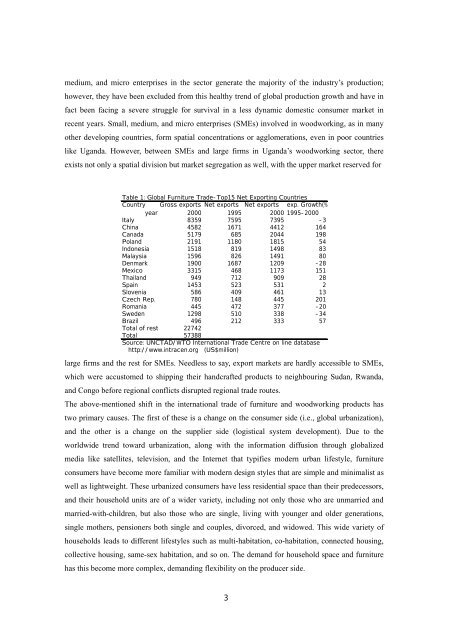Information - ARRIDE - IDE-JETRO
Information - ARRIDE - IDE-JETRO
Information - ARRIDE - IDE-JETRO
You also want an ePaper? Increase the reach of your titles
YUMPU automatically turns print PDFs into web optimized ePapers that Google loves.
medium, and micro enterprises in the sector generate the majority of the industry’s production;<br />
however, they have been excluded from this healthy trend of global production growth and have in<br />
fact been facing a severe struggle for survival in a less dynamic domestic consumer market in<br />
recent years. Small, medium, and micro enterprises (SMEs) involved in woodworking, as in many<br />
other developing countries, form spatial concentrations or agglomerations, even in poor countries<br />
like Uganda. However, between SMEs and large firms in Uganda’s woodworking sector, there<br />
exists not only a spatial division but market segregation as well, with the upper market reserved for<br />
<br />
<br />
<br />
<br />
<br />
<br />
<br />
<br />
<br />
<br />
<br />
<br />
<br />
<br />
<br />
<br />
<br />
<br />
<br />
<br />
<br />
<br />
<br />
large firms and the rest for SMEs. Needless to say, export markets are hardly accessible to SMEs,<br />
which were accustomed to shipping their handcrafted products to neighbouring Sudan, Rwanda,<br />
and Congo before regional conflicts disrupted regional trade routes.<br />
The above-mentioned shift in the international trade of furniture and woodworking products has<br />
two primary causes. The first of these is a change on the consumer side (i.e., global urbanization),<br />
and the other is a change on the supplier side (logistical system development). Due to the<br />
worldwide trend toward urbanization, along with the information diffusion through globalized<br />
media like satellites, television, and the Internet that typifies modern urban lifestyle, furniture<br />
consumers have become more familiar with modern design styles that are simple and minimalist as<br />
well as lightweight. These urbanized consumers have less residential space than their predecessors,<br />
and their household units are of a wider variety, including not only those who are unmarried and<br />
married-with-children, but also those who are single, living with younger and older generations,<br />
single mothers, pensioners both single and couples, divorced, and widowed. This wide variety of<br />
households leads to different lifestyles such as multi-habitation, co-habitation, connected housing,<br />
collective housing, same-sex habitation, and so on. The demand for household space and furniture<br />
has this become more complex, demanding flexibility on the producer side.<br />
3




![Title [書評] 廣田義人著『東アジア工作機械工業の技術形成 ... - ARRIDE](https://img.yumpu.com/47139953/1/184x260/title-arride.jpg?quality=85)






